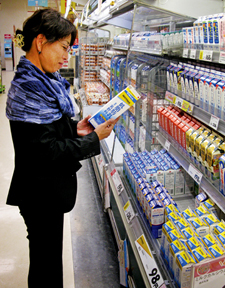During a trip to Japan this month, visits to food markets were eye-opening. There were both similarities and differences to the United States.
First of all, Class 1 fluid milk use in Japan (they call it "city milk") is in steep decline. Since 1994, total consumption per year is down nearly 20 percent. Three big reasons are a population that is gradually falling, also steadily aging, and an infant birthrate that is the second lowest in the world.
In dairy cases we saw a wide variety of milks, both conventional and organic. Milkfat contents varied tremendously. In just one store we saw milks with 2.0, 2.5, 3.5, 3.6, 3.7 and 4.2 percent milkfat – but none lower and no nonfat.

Prices varied even more. In a very large supermarket a name brand milk cost the equivalent of $10.08 per gallon. The low-cost "store brand" was the equivalent of $4.76 per gallon. Organic milk cost the equivalent of $22.96 per gallon. However, milk was not sold by the gallon.
At every store, all dairy product package sizes were small. The biggest fluid milk container was one liter (1.06 quarts), but half and quarter liter sizes were most common. The largest cheese package was 500 grams (1.1 pounds) of shredded mozzarella. Steak was typically in packages of 100 grams (3.5 ounces). Small sizes, we were told, are necessary because the typical refrigerator in Japanese homes is small, and most consumers shop every one or two days.
Raw product quality standards and customer safety assurance are extremely high. On the carton of one of the fluid milk brands was printed the name and photo of the farmer whose cows produced the milk inside it. One market also advertised that it carried no dairy products of any kind from China.
First of all, Class 1 fluid milk use in Japan (they call it "city milk") is in steep decline. Since 1994, total consumption per year is down nearly 20 percent. Three big reasons are a population that is gradually falling, also steadily aging, and an infant birthrate that is the second lowest in the world.
In dairy cases we saw a wide variety of milks, both conventional and organic. Milkfat contents varied tremendously. In just one store we saw milks with 2.0, 2.5, 3.5, 3.6, 3.7 and 4.2 percent milkfat – but none lower and no nonfat.

Prices varied even more. In a very large supermarket a name brand milk cost the equivalent of $10.08 per gallon. The low-cost "store brand" was the equivalent of $4.76 per gallon. Organic milk cost the equivalent of $22.96 per gallon. However, milk was not sold by the gallon.
At every store, all dairy product package sizes were small. The biggest fluid milk container was one liter (1.06 quarts), but half and quarter liter sizes were most common. The largest cheese package was 500 grams (1.1 pounds) of shredded mozzarella. Steak was typically in packages of 100 grams (3.5 ounces). Small sizes, we were told, are necessary because the typical refrigerator in Japanese homes is small, and most consumers shop every one or two days.
Raw product quality standards and customer safety assurance are extremely high. On the carton of one of the fluid milk brands was printed the name and photo of the farmer whose cows produced the milk inside it. One market also advertised that it carried no dairy products of any kind from China.









